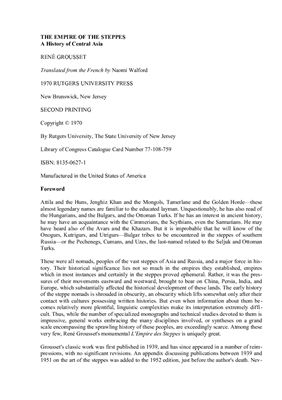New Brunswick: Rutgers Univercity Press, 1970. - 398 pp.
Attila and the Huns, Jenghiz Khan and the Mongols, Tamerlane and the Golden Horde—these almost legendary names are familiar to the educated layman. Unquestionably, he has also read of the Hungarians, and the Bulgars, and the Ottoman Turks. If he has an interest in ancient history, he may have an acquaintance with the Cimmerians, the Scythians, even the Sarmatians. He may have heard also of the Avars and the Khazars. But it is improbable that he will know of the Onogurs, Kutrigurs, and Utrigurs—Bulgar tribes to be encountered in the steppes of southe Russia—or the Pechenegs, Cumans, and Uzes, the last-named related to the Seljuk and Ottoman Turks.
These were all nomads, peoples of the vast steppes of Asia and Russia, and a major force in history. Their historical significance lies not so much in the empires they established, empires which in most instances and certainly in the steppes proved ephemeral. Rather, it was the pressures of their movements eastward and westward, brought to bear on China, Persia, India, and Europe, which substantially affected the historical development of these lands. The early history of the steppe nomads is shrouded in obscurity, an obscurity which lifts somewhat only after their contact with cultures possessing written histories. But even when information about them becomes relatively more plentiful, linguistic complexities make its interpretation extremely difficult. Thus, while the number of specialized monographs and technical studies devoted to them is impressive, general works embracing the many disciplines involved, or syntheses on a grand scale encompassing the sprawling history of these peoples, are exceedingly scarce. Atmong these very few, Ren? Grousset's monumental L'Empire des Steppes is uniquely great.
Grousset's classic work was first published in 1939, and has since appeared in a number of reimpressions, with no significant revisions. An appendix discussing publications between 1939 and 1951 on the art of the steppes was added to the 1952 edition, just before the author's death. Nevertheless, the main body of the text has retained its validity, and remains to this day the most engrossing and vital general account of this immense subject.
The present volume, the first edition in English, was translated by Naomi Walford from the French edition of 1952. Traian Stoianovich, Professor of History at Rutgers University, checked the translation and helped to establish uniformity in nomenclature and transliteration. The late James F. McRee, Jr., completed the final typographic editing of the text. The outdated appendix on the art of the steppes was dropped, and the copious annotation was brought into conformity with present-day academic usage. A large and comprehensive index was compiled and added, and nineteen maps were prepared expressly for this edition. Our aim throughout has been to make available an English-language edition useful to the general reader as well as to the specialist, but above all an edition which retains the majestic sweep and grandeur, as well as the overriding intellectual grasp, of Grousset's original masterwork.
Attila and the Huns, Jenghiz Khan and the Mongols, Tamerlane and the Golden Horde—these almost legendary names are familiar to the educated layman. Unquestionably, he has also read of the Hungarians, and the Bulgars, and the Ottoman Turks. If he has an interest in ancient history, he may have an acquaintance with the Cimmerians, the Scythians, even the Sarmatians. He may have heard also of the Avars and the Khazars. But it is improbable that he will know of the Onogurs, Kutrigurs, and Utrigurs—Bulgar tribes to be encountered in the steppes of southe Russia—or the Pechenegs, Cumans, and Uzes, the last-named related to the Seljuk and Ottoman Turks.
These were all nomads, peoples of the vast steppes of Asia and Russia, and a major force in history. Their historical significance lies not so much in the empires they established, empires which in most instances and certainly in the steppes proved ephemeral. Rather, it was the pressures of their movements eastward and westward, brought to bear on China, Persia, India, and Europe, which substantially affected the historical development of these lands. The early history of the steppe nomads is shrouded in obscurity, an obscurity which lifts somewhat only after their contact with cultures possessing written histories. But even when information about them becomes relatively more plentiful, linguistic complexities make its interpretation extremely difficult. Thus, while the number of specialized monographs and technical studies devoted to them is impressive, general works embracing the many disciplines involved, or syntheses on a grand scale encompassing the sprawling history of these peoples, are exceedingly scarce. Atmong these very few, Ren? Grousset's monumental L'Empire des Steppes is uniquely great.
Grousset's classic work was first published in 1939, and has since appeared in a number of reimpressions, with no significant revisions. An appendix discussing publications between 1939 and 1951 on the art of the steppes was added to the 1952 edition, just before the author's death. Nevertheless, the main body of the text has retained its validity, and remains to this day the most engrossing and vital general account of this immense subject.
The present volume, the first edition in English, was translated by Naomi Walford from the French edition of 1952. Traian Stoianovich, Professor of History at Rutgers University, checked the translation and helped to establish uniformity in nomenclature and transliteration. The late James F. McRee, Jr., completed the final typographic editing of the text. The outdated appendix on the art of the steppes was dropped, and the copious annotation was brought into conformity with present-day academic usage. A large and comprehensive index was compiled and added, and nineteen maps were prepared expressly for this edition. Our aim throughout has been to make available an English-language edition useful to the general reader as well as to the specialist, but above all an edition which retains the majestic sweep and grandeur, as well as the overriding intellectual grasp, of Grousset's original masterwork.

